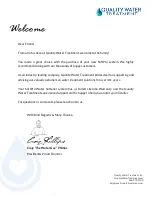
SM64200
February
2007
7
mechanical stops built into the Body (6) of
the unit. This stop is also utilized as a
wear strip to prevent wear of the Screws
(26) that retain the Arm onto the nozzle.
The Knob (38) is a sacrificial part that is
also used for major part wear prevention.
Prior to each fueling of an aircraft it is
recommended that the operator check the
stop for the Arm to be sure it is
functioning correctly. If the stop portion of
the Body is worn down to where the
Screws are being worn, then the nozzle
should be replaced.
If the Knob is worn badly such that the
Screws are in danger of being worn then
the Knob should be replaced prior to the
next refueling.
The connecting end of the nozzle should
be checked to assure that the slots in the
Body (6) and Retainer (9) are aligned
before trying to connect to the aircraft or
adapter. If the slots are not aligned place
the nozzle onto the adapter as to connect
and pressing in toward the adapter rotate
the nozzle as far as possible in the
clockwise direction. This will cam the
retainer into the installation position to
allow connection.
4.2
LEAKAGE DURING REFUELING
Any leakage from the nozzle or the
mating joint with the aircraft should be
cause for stopping the operation and the
nozzle should be replaced. The following
paragraphs describe the possible leakage
paths with the 64200.
4.2.1
NOSE SEAL LEAKAGE
During the refueling operation the
operator should note any leakage from
any portion of the nozzle. Nose Seal (21)
leakage will be apparent if there is fuel
dripping or otherwise present at the
connection between the nozzle and the
aircraft adapter. If any leakage is present
during refueling, the operation should be
stopped and the nozzle replaced. There
are two possible leak paths, the Nose Seal
(21) or the O-ring (23) around the Nose
Seal. The nozzle should be overhauled to
prevent future leakage.
4.2.2
OPERATING ARM LEAKAGE
If leakage is present from the area of the
operating Arm (27A or B) then the O-ring
(35) will have to be replaced. Refueling
should not be continued if such leakage is
present.
4.2.3
SWIVEL JOINT LEAKAGE
There are two possible leak paths from
the swivel joint of the nozzle, from the O-
ring (41) and the seal in the mating part
or from the Gasket (2). The latter is
highly unlikely. If leakage is present, stop
refueling and replace the nozzle.
4.2.4 NOZZLE
BODY
PLUGS/ACCESSORIES
The 64200 has two accessories ports in
the side of the body. These are shipped
from the factory with pipe Plugs (5)
installed. Other accessories are available
either from Carter or other manufacturers
that can be installed in one or both ports.
Tightening the plugs or the accessory can
normally stop leakage from either of these
ports. Do not refuel with leakage from
these devices.
Note!
Before installing another manufacturer's
accessory in either port be sure that the
item when installed does not interfere with
the working mechanism inside the nozzle.
5.0 SPECIAL
TOOLS
The following special tools are
recommended for proper repair and or
overhaul of the nozzle:
•
S204451 - Standard three lug
bayonet adapter flange or equivalent.
(This item should have a handle of a
sort mounted to two of the mounting
holes to assist in turning it onto the
nozzle).
•
6958CG or 6958CH Adapter or
equivalent.
•
61607 Ball (10 & 11) Assembly Tool
•
WL4680 Torque Wrench or
Standard torque wrench is required
for some disassembly and re-
assembly. WL4680 includes several
sockets for special usage on Carter
products.
Summary of Contents for Carter 64200
Page 15: ...SM64200 February 2007 15 FIGURE 1 64200 PARTS BREAKDOWN ...
Page 16: ...SM64200 February 2007 16 FIGURE 2 64200 OPTIONS ...
Page 17: ...SM64200 February 2007 17 FIGURE 3 Holding Bracket Circular and Stirrup Handle Installations ...
Page 18: ...SM64200 February 2007 18 CONTINUITY CLIP INSTALLATION FIGURE 5 POPPET COTTER PIN INSTALLATION ...
Page 21: ...SM64200 February 2007 21 ...







































